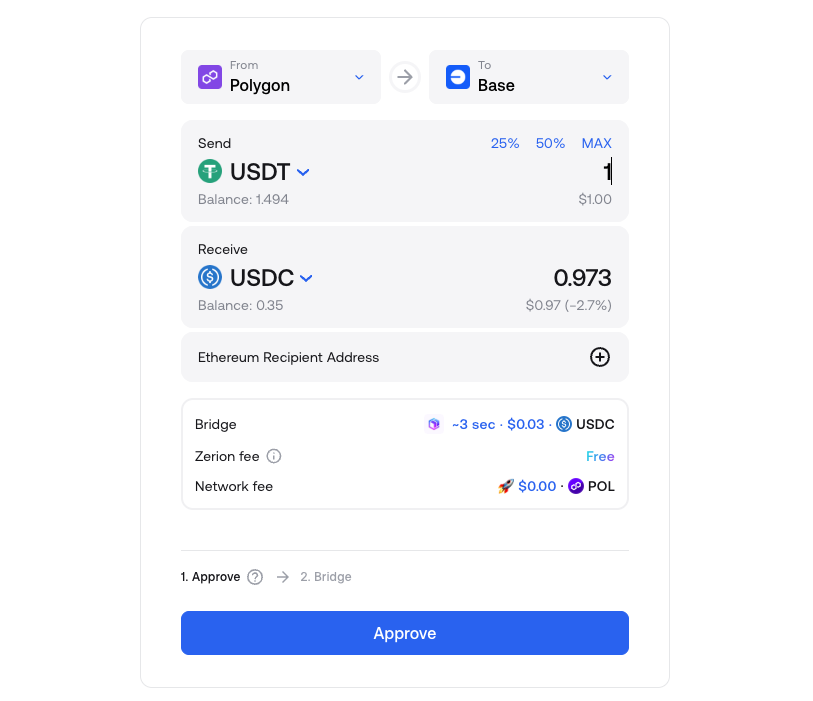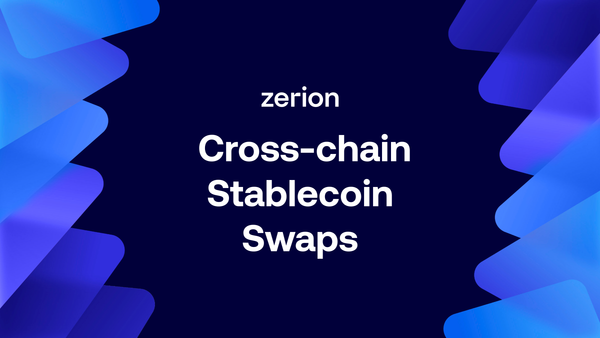If you need to swap stablecoins across blockchains fast, Zerion is the answer. You can find the best swap and bridge rates, complete it in a single transaction, and then track 'send' and 'receive' on both chains in a unified transaction history feed. You can start by connecting your existing wallet to Zerion. Try it now.
In this post, you can learn everything you should know about cross-chain stablecoin swaps.
Understanding Cross-Chain Stablecoin Swaps
What Are Cross-Chain Stablecoin Swaps and Why Do They Matter?
Cross-chain stablecoin swaps let you move your crypto dollars (USDT, USDC, DAI) between blockchains like Ethereum, Arbitrum, Polygon, or Base. This is essential in DeFi, where opportunities pop up on different networks and moving fast can mean better rates, bigger yields, or just peace of mind. Stablecoins exist on many chains, but moving them isn’t always straightforward. Blockchains don’t talk to each other natively. That’s where cross-chain swaps and tools like Zerion come in.
Centralized solutions offer speed, but you have to trust a third party. Decentralized cross-chain solutions like bridges and DEXes keep you in control of your funds while letting you move assets wherever the market demands. Zerion aggregates offers from all bridges and DEXes, so you don’t need to figure out which one is fastest or cheapest. Zerion does it for you.
How Fast Cross-Chain Swaps Work
Token bridges are the infrastructure that make cross-chain swaps possible.
Bridges lock your stablecoin on one network and release an equivalent on another. Modern bridges use smart contracts to handle this securely and transparently. Some, like atomic swaps, guarantee your trade is trustless: both sides are completed or nothing happens.
Liquidity pools add another layer of speed. If there’s deep liquidity on both sides, your transaction is more likely to be instant, and you avoid costly delays.
Zerion aggregates liquidity from all major bridges and DEXs, so your cross-chain swap happens with maximum speed and minimum slippage.

What Affects Swap Speed?
Not all bridges and routes are equal. Transaction speed depends on:
- The specific bridging protocol (for example, Bungee, Stargate, Hop, or Connext)
- The level of network congestion on the source and destination blockchains
- How much liquidity is available for your stablecoin on each side
Atomic swaps and liquidity pools usually provide faster swaps, but some protocols are optimized for speed, while others focus on lowest fees or maximum decentralization. Zerion finds you cross-chain swap that are the fastest and cheapest.
Implementing Fast Cross-Chain Stablecoin Swaps
When doing a cross-chain stablecoin swap, you essentially do two transactions:
- Swap from one stablecoin (e.g. USDC) to another (e.g. USDT)
- Bridge the stablecoin from one chain (e.g. Base) to another network (e.g. mainnet Ethereum)
The order of these transactions doesn't really matter but it can affect the fees you pay and the speed of execution. For example, swaps on Ethereum are more expensive and slow.
To remove the guesswork, you can use the Zerion web app or Zerion Wallet for this.
Choosing the Best Bridge
With Zerion, you don’t have to compare bridges yourself. The app evaluates speed, fees, and reliability across protocols, then auto-selects the optimal route. If you want more control, you can inspect the route before confirming your swap. If you’re in a rush, just approve the trade and let Zerion’s aggregator tech handle the rest.
Optimizing Your Transaction
Set your slippage low if you want price certainty, or raise it a bit if you need instant execution. Zerion gives you the option. You can see a clear breakdown of expected fees before you swap.
DEX Aggregators and Liquidity Hubs
Zerion’s DEX aggregator taps into every major liquidity hub for stablecoins. The result is faster swaps and lower slippage. Smart routing finds the shortest, cheapest path, so your stablecoins land on the destination chain with no hassle.
Wallet Setup for Speed
The Zerion web app supports every major wallet, including MetaMask, Ledger, and many others. You can also import your wallet address and just use Zerion Wallet. Zerion handles all your cross-chain connections in one place, keeping your private keys secure and your experience seamless.
Real-World Use Cases
Why do people swap cross-chain stablecoins quickly? It’s about chasing better yield, jumping on arbitrage opportunities, or moving assets in a hurry when volatility spikes. Fast swaps are also vital for managing cross-chain collateral and ensuring liquidity for DeFi lending platforms. Zerion’s unified transaction history helps you audit all your moves, no matter how complex.
Troubleshooting Slow Swaps
Sometimes a network is jammed, or a transaction gets stuck. Zerion shows pending or failed swaps. No more guessing why your stablecoins haven’t arrived. If there is a problem, Zerion’s support can walk you through the fix.
FAQ
What are the main advantages of using Zerion for cross-chain stablecoin swaps?
Zerion finds the best swap and bridge rates, completes your transaction in one go, and lets you track everything in one feed. No more checking DEXes and bridge fees. You also don't need to use multiple blockc explorers to track your transactions.
Which stablecoins can I swap cross-chain in Zerion?
You can swap all major stablecoins—USDT, USDC, DAI, and more—across all major EVM chains and Solana.
Is Zerion non-custodial?
Yes. You stay in control of your assets at all times. Zerion does not hold your funds or private keys.
How fast are cross-chain stablecoin swaps in Zerion?
Swaps are typically completed within minutes, depending on network congestion and bridge availability. Zerion always picks the fastest possible route.
What if a transaction gets stuck?
Zerion flags pending or failed transactions so you know when to try again.
Do I need to create a new wallet?
No. You can connect your existing wallet or import it into Zerion.
For the fastest, easiest, and most reliable cross-chain stablecoin swaps, Zerion is all you need. Try Zerion now.

